the beginning of yosemite tourism - Yosemite Online
the beginning of yosemite tourism - Yosemite Online
the beginning of yosemite tourism - Yosemite Online
- No tags were found...
Create successful ePaper yourself
Turn your PDF publications into a flip-book with our unique Google optimized e-Paper software.
P R E S I D E N T I A L P O L I T I C SA N D H E T C H H E T C H YEditor’s note: The following is an excerpt from <strong>the</strong>author’s recently published book entitled Dam!Water, Power, Politics, and Preservation in HetchHetchy and <strong>Yosemite</strong> National Park (Pan<strong>the</strong>onBooks, 2005). Mr. Simpson will be <strong>the</strong> keynotespeaker at <strong>the</strong> <strong>Yosemite</strong> Association annual meetingin Tuolumne Meadows on September 10.As [San Francisco city engineer Marsden] Mansonprepared his plan and cost estimate <strong>the</strong> spring[1909] following <strong>the</strong> congressional setback, <strong>the</strong>fate <strong>of</strong> Phelan’s [Hetch Hetchy] project and <strong>the</strong> Garfieldpermit appeared fur<strong>the</strong>r in doubt when PresidentWilliam Howard Taft (1909-13) assumed <strong>of</strong>fice. ManyRepublicans assumed <strong>the</strong> new president would continue<strong>the</strong> Progressive conservation policies <strong>of</strong> his popularpredecessor. He didn’t. The new president wasn’t a truebeliever in <strong>the</strong> cause like his rambunctious predecessor.To <strong>the</strong> Progressives, conservation meant <strong>the</strong> protection<strong>of</strong> valuable public lands from private ownership andpotential abuse, and <strong>the</strong> wise development <strong>of</strong> timber,minerals, grazing, water, and recreation on those landsthrough cooperation directed by government scientistsand enlightened bureaucrats. Both presidents appreciatedHetch Hetchy’s spectacular scenery, and both struggledwith how best to manage it. Roosevelt’s Progressive conservationvalues led him to favor <strong>the</strong> utilitarian, multipleuseapproach. Taft’s preference for resource developmentby <strong>the</strong> private sector along with legal concerns led himto hesitate in permitting such uses in national parks orforests, or in creating new ones. Roosevelt fumed, overreactingto Taft’s resource policies in <strong>the</strong> belief that <strong>the</strong>ynecessarily favored <strong>the</strong> interests <strong>of</strong> big business over publicand environmental welfare, backsliding to <strong>the</strong> shortsightedpolicies <strong>of</strong> <strong>the</strong> 1800s.As Taft took hold, Pinchot and <strong>the</strong> o<strong>the</strong>r true believersbecame increasingly angry about <strong>the</strong> policy changesand <strong>the</strong>ir lessened influence. They tried unsuccessfully toconvert <strong>the</strong> new president to <strong>the</strong>ir gospel or to bypass hispolicies. Some in <strong>the</strong> former Roosevelt coterie resignedin protest. The powerful chief forester chose to stay andfight. Hetch Hetchy reflected <strong>the</strong> widening rift. Pinchothad lobbied hard to win approval <strong>of</strong> <strong>the</strong> Garfield permit;now, to <strong>the</strong> dismay <strong>of</strong> many Progressive Republicans, Taftappointed Richard A. Ballinger, a like-minded land attorney,as secretary <strong>of</strong> <strong>the</strong> interior.Pinchot had never approved <strong>of</strong> <strong>the</strong> new secretary; andhad contested his appointment. Ballinger was a respectedBY JOHN WARFIELD SIMPSONattorney and former mayor <strong>of</strong> Seattle, who had worked toreform <strong>the</strong> notoriously corrupt General Land Office duringa short tenure as commissioner several years earlier.But integrity aside, Pinchot fundamentally disagreed withBallinger’s (and Taft’s) land management philosophy.Likewise, Ballinger thought some <strong>of</strong> Pinchot’s freewheelingagreements were illegal.Tensions between Taft and Ballinger and <strong>the</strong> holdoversfrom <strong>the</strong> Roosevelt administration tightened, quicklystraining <strong>the</strong>ir working relationship to <strong>the</strong> breaking point.It all snapped during <strong>the</strong> so-called Ballinger-Pinchotaffair, which unfortunately evolved into a public debateargued in <strong>the</strong> national press and focused more on personalityand politics than <strong>the</strong> men’s important underlyingpolicy differences.In autumn 1909, Ballinger’s critics accused him <strong>of</strong>indirectly asserting pressure for <strong>the</strong> approval <strong>of</strong> a potentiallyfraudulent Alaskan coal claim without sufficientinvestigation; <strong>the</strong> land claim had been submitted by some<strong>of</strong> his former law clients. The complicated issues datedto Ballinger’s term as commissioner <strong>of</strong> <strong>the</strong> general land<strong>of</strong>fice and involved nuances in several land laws. Whe<strong>the</strong>ror not <strong>the</strong> accusations were founded, personal vindictivenessand politics clearly motivated some participants.Accusations <strong>of</strong> wrongdoing were hurled back and forthbetween Ballinger and his accusers, especially Pinchot.President Taft had little patience for <strong>the</strong> mudslinging,accepting his attorney general’s belief after a cursoryinvestigation that Ballinger had not breached any ethics.The controversy exploded in early 1910 when Iowasenator Jonathan Dolliver read to <strong>the</strong> body a letter writtento him by Pinchot that defended Ballinger’s accuserswhile extolling <strong>the</strong>policies <strong>of</strong> <strong>the</strong> forestservice underPinchot’s leadership.President Taftpromptly firedPinchot for insubordination.Pinchotstruck back,leading a publicattack to discreditSecretary Ballingerand <strong>the</strong> Taft conservationpolicies.Meanwhile,Congress con-10 Y O S E M I T E A S S O C I A T I O N , S U M M E R 2 0 0 5


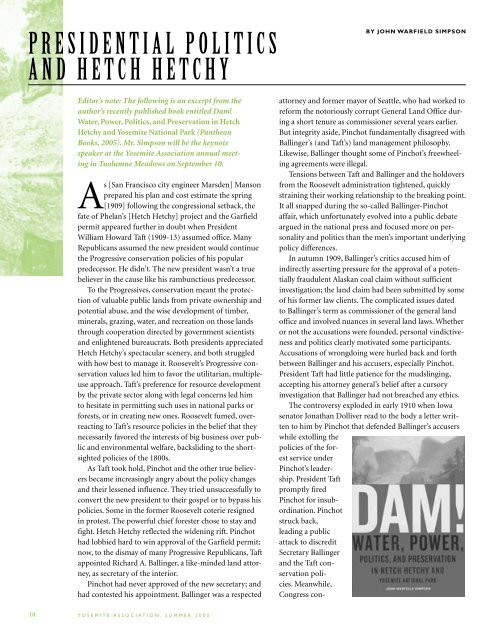

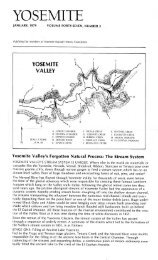
![(March 1982) [PDF] “We Are Pleased to Announce†- Yosemite Online](https://img.yumpu.com/51299748/1/190x242/march-1982-pdf-aeuroewe-are-pleased-to-announceaeur-yosemite-online.jpg?quality=85)
![[PDF] Old Horny, Yosemite's Unicorn Buck - Yosemite Online](https://img.yumpu.com/51269869/1/184x260/pdf-old-horny-yosemites-unicorn-buck-yosemite-online.jpg?quality=85)
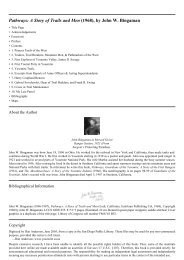
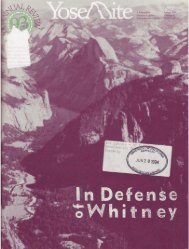
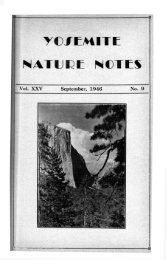
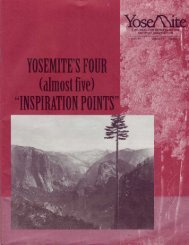
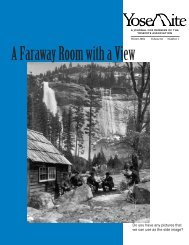
![1985 [PDF] - Yosemite](https://img.yumpu.com/48128837/1/184x260/1985-pdf-yosemite.jpg?quality=85)



